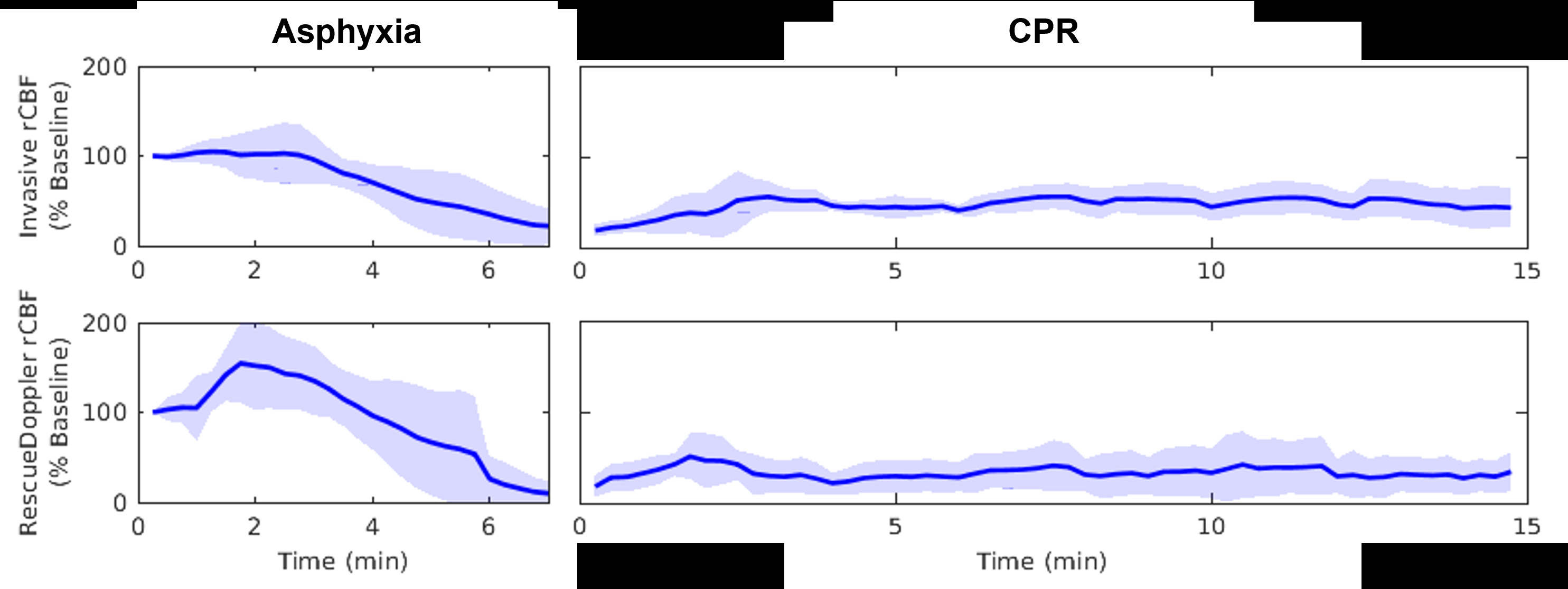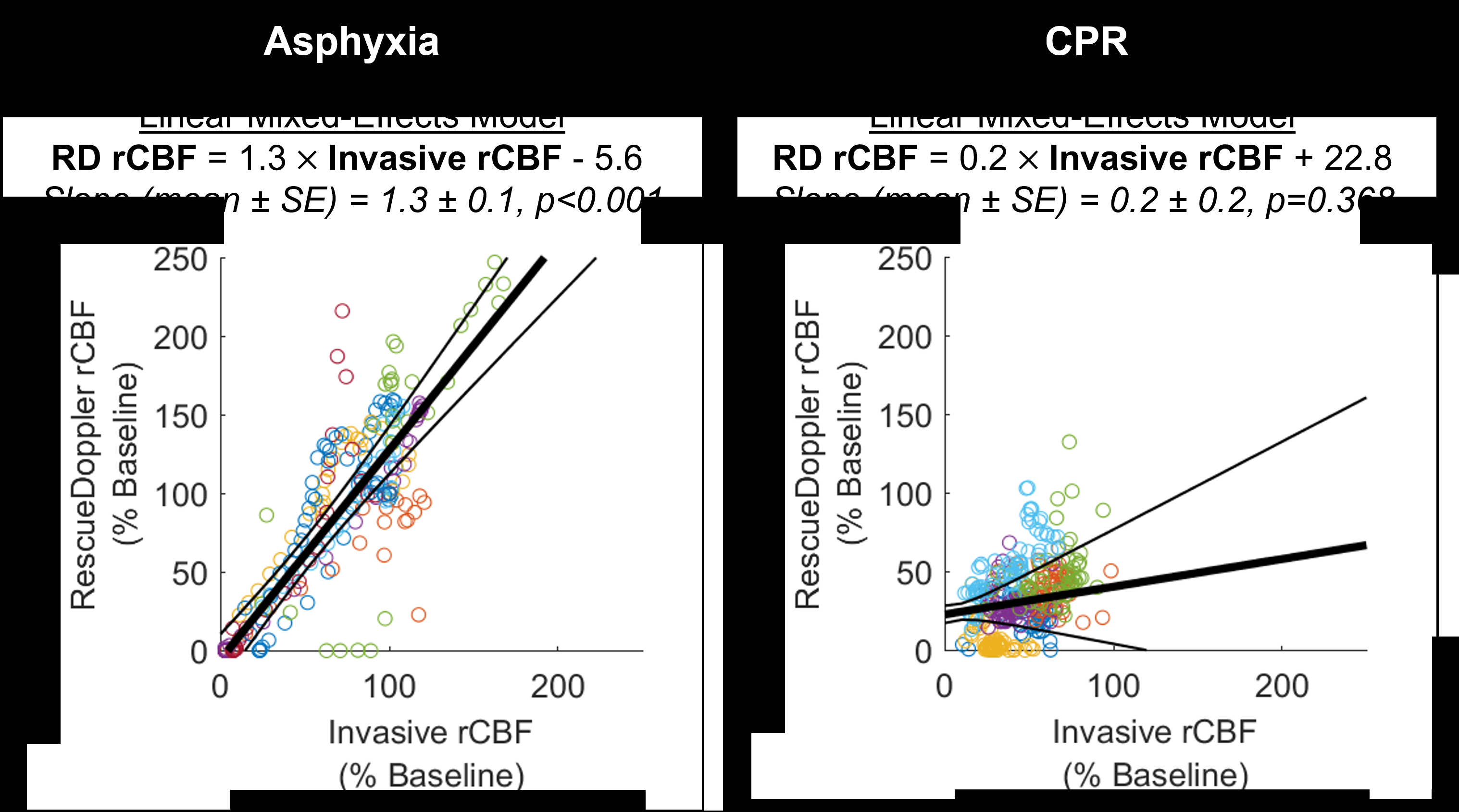Final ID: Sa1305
Hands Free Carotid Doppler Correlates with Cerebral Blood Flow in a Pediatric Porcine Model of Asphyxia Associated Cardiac Arrest
Abstract Body: Introduction: Preservation of cerebral blood flow (CBF) during and around the time of cardiac arrest (CA) is critical, but validated measurement methods are lacking. Carotid Doppler time averaged velocity (TAV) may be an effective, non-invasive surrogate for CBF.
Hypothesis: A novel hand-free continuous carotid Doppler ultrasound (RescueDoppler; RD) will be correlated with an invasive measurement of CBF (laser Doppler flowmetry) in a swine model of asphyxia-associated pediatric CA.
Methods: Piglets (1-month-old) were anesthetized and intubated. The RD probe was placed over left common carotid artery and invasive CBF (laser Doppler flowmetry) measured via right anterior burr hole. After 7m of asphyxia by endotracheal tube clamping, ventricular fibrillation was induced and treated by hemodynamic-directed cardiopulmonary resuscitation (CPR) (compression depth titrated to systolic blood pressure 90 mmHg and vasopressors to coronary perfusion pressure 20 mmHg). Continuous data outputs were block-averaged in 15s epochs during asphyxia (n=8) and CPR (n=6), then converted to relative values as a percentage of baseline to account for differing units between devices. Repeated measures correlation, a technique to determine the within-subject relationship among paired measures assessed on repeated occasions (R package ‘rmcorr’), was used to assess the correlation between devices (reported as rmcorr with 95% confidence interval). Linear mixed effects modeling assessed the quantitative relationship between devices (reported as mean ± standard error).
Results: During asphyxia, RD TAV is strongly correlated with invasive CBF (rmcorr = 0.84 [0.80, 0.87]) with a 1.3 ± 0.1% change in RD TAV per 1% change in invasive CBF (p<0.01). This correlation is weaker, but significant during CPR (rmcorr=0.31 [0.22, 0.41]) with a quantitative relationship between RD TAV and invasive CBF that did not reach significance (0.2±0.2%, p=0.37).
Conclusions: RescueDoppler is correlated with invasive CBF during asphyxia and, to a lesser degree, during CA in pediatric swine. The narrow physiologic range during hemodynamic-directed CPR and motion artifact may contribute to reduced correlation during CPR. Future study may be strengthened by increased dynamic range of CBF during CPR and improved device stabilization. RescueDoppler is a novel, non-invasive CBF surrogate in this pediatric porcine model and may be a promising physiologic tool for targeted CPR to improve neurologic outcomes.
Hypothesis: A novel hand-free continuous carotid Doppler ultrasound (RescueDoppler; RD) will be correlated with an invasive measurement of CBF (laser Doppler flowmetry) in a swine model of asphyxia-associated pediatric CA.
Methods: Piglets (1-month-old) were anesthetized and intubated. The RD probe was placed over left common carotid artery and invasive CBF (laser Doppler flowmetry) measured via right anterior burr hole. After 7m of asphyxia by endotracheal tube clamping, ventricular fibrillation was induced and treated by hemodynamic-directed cardiopulmonary resuscitation (CPR) (compression depth titrated to systolic blood pressure 90 mmHg and vasopressors to coronary perfusion pressure 20 mmHg). Continuous data outputs were block-averaged in 15s epochs during asphyxia (n=8) and CPR (n=6), then converted to relative values as a percentage of baseline to account for differing units between devices. Repeated measures correlation, a technique to determine the within-subject relationship among paired measures assessed on repeated occasions (R package ‘rmcorr’), was used to assess the correlation between devices (reported as rmcorr with 95% confidence interval). Linear mixed effects modeling assessed the quantitative relationship between devices (reported as mean ± standard error).
Results: During asphyxia, RD TAV is strongly correlated with invasive CBF (rmcorr = 0.84 [0.80, 0.87]) with a 1.3 ± 0.1% change in RD TAV per 1% change in invasive CBF (p<0.01). This correlation is weaker, but significant during CPR (rmcorr=0.31 [0.22, 0.41]) with a quantitative relationship between RD TAV and invasive CBF that did not reach significance (0.2±0.2%, p=0.37).
Conclusions: RescueDoppler is correlated with invasive CBF during asphyxia and, to a lesser degree, during CA in pediatric swine. The narrow physiologic range during hemodynamic-directed CPR and motion artifact may contribute to reduced correlation during CPR. Future study may be strengthened by increased dynamic range of CBF during CPR and improved device stabilization. RescueDoppler is a novel, non-invasive CBF surrogate in this pediatric porcine model and may be a promising physiologic tool for targeted CPR to improve neurologic outcomes.
More abstracts on this topic:
Adoptive transfer of placental CD4+ T Cells from preeclamptic patients with a history of COVID-19 causes hypertension and cognitive dysfunction postpartum in a pregnant rat model of preeclampsia
Deer Evangeline, Simmons Kimberly, Herrock Owen, Campbell Nathan, Roman Richard, Zheng Baoying, Morris Rachael, Lamarca Babbette
Intrauterine Tobacco Smoke Exposure Affects Cardiac Geometry and Function in InfantsHarada Kenji, Harada Yukiko, Hatakeyama-sasaki Miho, Nakamoto Yuichi, Toyono Manatomo


